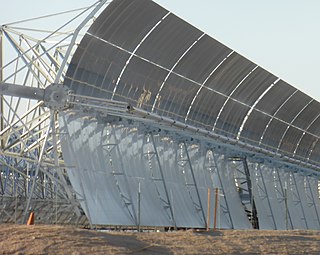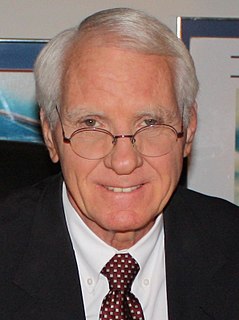
Renewable energy is useful energy that is collected from renewable resources, which are naturally replenished on a human timescale, including carbon neutral sources like sunlight, wind, rain, tides, waves, and geothermal heat. The term often also encompasses biomass as well, whose carbon neutral status is under debate. This type of energy source stands in contrast to fossil fuels, which are being used far more quickly than they are being replenished.

Solar energy is radiant light and heat from the Sun that is harnessed using a range of ever-evolving technologies such as solar heating, photovoltaics, solar thermal energy, solar architecture, molten salt power plants and artificial photosynthesis.

Solar thermal energy (STE) is a form of energy and a technology for harnessing solar energy to generate thermal energy for use in industry, and in the residential and commercial sectors.

A parabolic trough is a type of solar thermal collector that is straight in one dimension and curved as a parabola in the other two, lined with a polished metal mirror. The sunlight which enters the mirror parallel to its plane of symmetry is focused along the focal line, where objects are positioned that are intended to be heated. In a solar cooker, for example, food is placed at the focal line of a trough, which is cooked when the trough is aimed so the Sun is in its plane of symmetry.

Southern California Edison, the largest subsidiary of Edison International, is the primary electricity supply company for much of Southern California. It provides 15 million people with electricity across a service territory of approximately 50,000 square miles. However, the Los Angeles Department of Water and Power, San Diego Gas & Electric (SDG&E), Imperial Irrigation District, and some smaller municipal utilities serve substantial portions of the southern California territory. The northern part of the state is generally served by the Pacific Gas & Electric Company of San Francisco. Other investor-owned utilities (IOUs) in California include SDG&E, PacifiCorp, Bear Valley Electric, and Liberty Utilities.
Stirling Energy Systems is a Scottsdale, Arizona-based company which developed equipment for utility-scale renewable energy power plants and distributed electrical generating systems using parabolic dish and stirling engine technology, touted as the highest efficiency solar technology.

Nevada Solar One is a concentrated solar power plant, with a nominal capacity of 64 MW and maximum steam turbine power output up to 72 MW net (75 MW gross), spread over an area of 400 acres (160 ha). The projected CO2 emissions avoided is equivalent to taking approximately 20,000 cars off the road. The project required an investment of $266 million USD, and the project officially went into operation in June 2007. Electricity production is estimated to be 134 GWh (gigawatt hours) per year.

World energy consumption is the total energy produced and used by humans. Typically measured per year, it involves all energy harnessed from every energy source applied towards activity across all industrial and technological sectors, in every country. It does not include energy from food. World energy consumption has implications for the socio-economic-political sphere.

Renewable energy commercialization involves the deployment of three generations of renewable energy technologies dating back more than 100 years. First-generation technologies, which are already mature and economically competitive, include biomass, hydroelectricity, geothermal power and heat. Second-generation technologies are market-ready and are being deployed at the present time; they include solar heating, photovoltaics, wind power, solar thermal power stations, and modern forms of bioenergy. Third-generation technologies require continued R&D efforts in order to make large contributions on a global scale and include advanced biomass gasification, hot-dry-rock geothermal power, and ocean energy. As of 2012, renewable energy accounts for about half of new nameplate electrical capacity installed and costs are continuing to fall.
For solar power, South Asia has the ideal combination of both high solar insolation and a high density of potential customers.

According to preliminary data from the US Energy Information Administration, renewable energy accounted for about 11% of total primary energy consumption and about 17% of the domestically produced electricity in the United States in 2018. Hydroelectric power is currently the largest producer of renewable electricity in the country, generating around 6.5% of the nation's total electricity in 2016 as well as 45.71% of the total renewable electricity generation. The United States is the fourth largest producer of hydroelectricity in the world after China, Canada and Brazil.

China is the world's leading country in electricity production from renewable energy sources, with over double the generation of the second-ranking country, the United States. By the end of 2019, the country had a total capacity of 790GW of renewable power, mainly from hydroelectric, solar and wind power. By the end of 2019, China's hydropower capacity reached 356 GW. China's installed capacity of solar power reached 240 GW in 2020. As of Q3 2020, China's wind power capacity was 224 GW. China's renewable energy sector is growing faster than its fossil fuels and nuclear power capacity.

Solar power is the conversion of energy from sunlight into electricity, either directly using photovoltaics (PV), indirectly using concentrated solar power, or a combination. Concentrated solar power systems use lenses or mirrors and solar tracking systems to focus a large area of sunlight into a small beam. Photovoltaic cells convert light into an electric current using the photovoltaic effect.

The renewable-energy industry is the part of the energy industry focusing on new and appropriate renewable energy technologies. Investors worldwide have paid greater attention to this emerging industry in recent years. In many cases, this has translated into rapid renewable energy commercialization and considerable industry expansion. The wind power and solar photovoltaics (PV) industries provide good examples of this.

The PS20 solar power plant (PS20) solar power plant is a solar thermal energy plant in Sanlucar la Mayor near Seville in Andalusia, Spain. It was the world's most powerful solar power tower until the Ivanpah Solar Power Facility in California became operational in 2014. The 20 megawatt (MW) solar power tower produces electricity with large movable mirrors called heliostats.

Concentrated solar power systems generate solar power by using mirrors or lenses to concentrate a large area of sunlight onto a receiver. Electricity is generated when the concentrated light is converted to heat, which drives a heat engine connected to an electrical power generator or powers a thermochemical reaction.

Solar power in Arizona has the potential to, according to then-Governor Janet Napolitano, make Arizona "the Persian Gulf of solar energy". In 2012, Arizona had 1,106 MW of photovoltaic (PV) solar power systems, and 6 MW of concentrated solar power (CSP), bringing the total to over 1,112 megawatts (MW) of solar power. The Solana Generating Station is a 280 MW parabolic trough solar plant which is the largest plant of its type in the world. Solana includes 6 hours of power storage by molten salt. The plant will provide 5% of the power from Arizona Public Service, the state's largest utility.

Applications of the Stirling engine range from mechanical propulsion to heating and cooling to electrical generation systems. A Stirling engine is a heat engine operating by cyclic compression and expansion of air or other gas, the "working fluid", at different temperature levels such that there is a net conversion of heat to mechanical work. The Stirling cycle heat engine can also be driven in reverse, using a mechanical energy input to drive heat transfer in a reversed direction.

Harry William Braun III is an American renewable energy consultant, researcher, and political candidate. He was a congressional nominee in 1984 and 1986, and has been a presidential candidate in 2004, 2012, 2016, and 2020. He has published papers on the hydrogen economy, solar power, and photobiology.

Agrivoltaics or agrophotovoltaics (APV) is co-developing the same area of land for both solar photovoltaic power as well as for agriculture. This technique was originally conceived by Adolf Goetzberger and Armin Zastrow in 1981. The coexistence of solar panels and crops implies a sharing of light between these two types of production. Sheep and several crops can benefit from these systems, including fruit production.




















